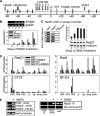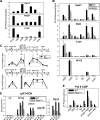Cohesin mediates chromatin interactions that regulate mammalian β-globin expression
- PMID: 21454523
- PMCID: PMC3093862
- DOI: 10.1074/jbc.M110.207365
Cohesin mediates chromatin interactions that regulate mammalian β-globin expression
Abstract
The β-globin locus undergoes dynamic chromatin interaction changes in differentiating erythroid cells that are thought to be important for proper globin gene expression. However, the underlying mechanisms are unclear. The CCCTC-binding factor, CTCF, binds to the insulator elements at the 5' and 3' boundaries of the locus, but these sites were shown to be dispensable for globin gene activation. We found that, upon induction of differentiation, cohesin and the cohesin loading factor Nipped-B-like (Nipbl) bind to the locus control region (LCR) at the CTCF insulator and distal enhancer regions as well as at the specific target globin gene that undergoes activation upon differentiation. Nipbl-dependent cohesin binding is critical for long-range chromatin interactions, both between the CTCF insulator elements and between the LCR distal enhancer and the target gene. We show that the latter interaction is important for globin gene expression in vivo and in vitro. Furthermore, the results indicate that such cohesin-mediated chromatin interactions associated with gene regulation are sensitive to the partial reduction of Nipbl caused by heterozygous mutation. This provides the first direct evidence that Nipbl haploinsufficiency affects cohesin-mediated chromatin interactions and gene expression. Our results reveal that dynamic Nipbl/cohesin binding is critical for developmental chromatin organization and the gene activation function of the LCR in mammalian cells.
© 2011 by The American Society for Biochemistry and Molecular Biology, Inc.
Figures




References
Publication types
MeSH terms
Substances
Grants and funding
- T32CA113265/CA/NCI NIH HHS/United States
- HD062951/HD/NICHD NIH HHS/United States
- DK044746/DK/NIDDK NIH HHS/United States
- HL065440/HL/NHLBI NIH HHS/United States
- T32 HD060555/HD/NICHD NIH HHS/United States
- R37 DK044746/DK/NIDDK NIH HHS/United States
- P01 HD052860/HD/NICHD NIH HHS/United States
- HD052860/HD/NICHD NIH HHS/United States
- R01 AR058548/AR/NIAMS NIH HHS/United States
- R21 HD062951/HD/NICHD NIH HHS/United States
- T32 CA113265/CA/NCI NIH HHS/United States
- R01 HL065440/HL/NHLBI NIH HHS/United States
- AR058548/AR/NIAMS NIH HHS/United States
- P30 CA062203/CA/NCI NIH HHS/United States
LinkOut - more resources
Full Text Sources
Research Materials

